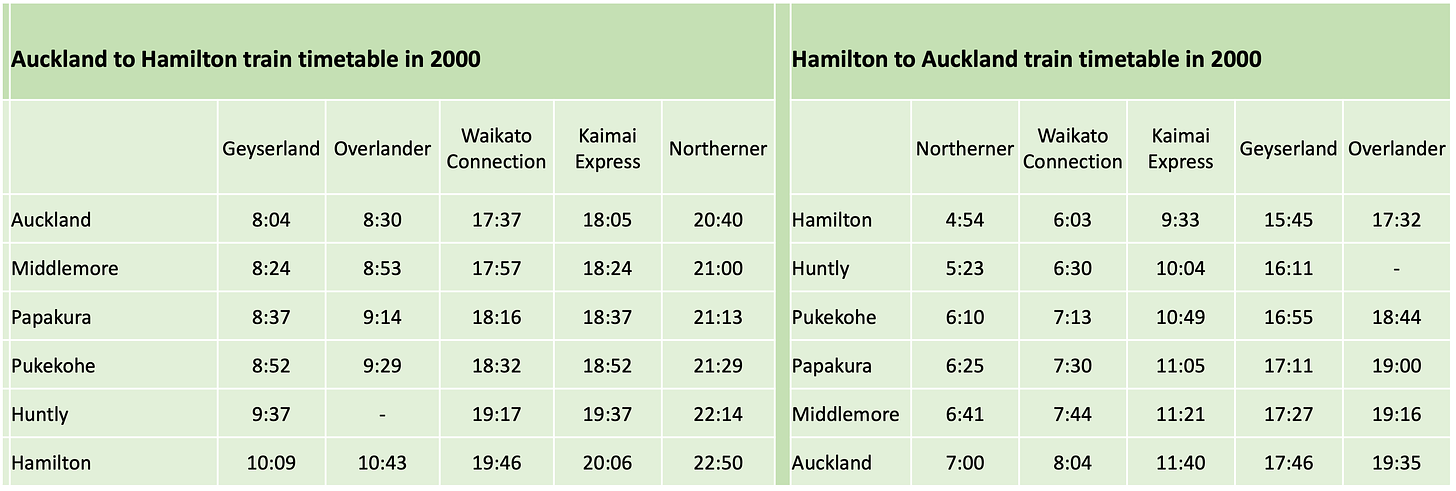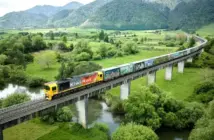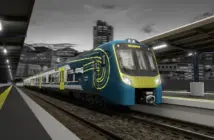The Te Huia passenger train from Hamilton to Auckland has been ordered to terminate early in Papakura until further notice after instances of it running red lights — Darren Davis explores how it came to this and who will ultimately pay the price

Te Huia has had a rough ride and already faced significant challenges to its very survival before the shock announcement on Tuesday 11 July 2023 of the service’s enforced truncation to Papakura. This was the result of a prohibition notice, issued under Section 28 of the Railways Act 2005, by Waka Kotahi, which had the immediate effect of terminating the Te Huia rail service at Papakura.
This means that the service cannot enter the Auckland electrified area and not stop at Puhinui, where it connects to the Airport Link bus to Auckland Airport, nor at Auckland Strand Station on the edge of Auckland City Centre. Te Huia customers travelling further into Auckland are now required to change to an AT Metro all-stops train or bus, using a different ticketing system, at Papakura Station. This service truncation significantly reduces the attractiveness of Te Huia as an inter-regional travel option and makes it less competitive with car driving in terms of the overall end-to-end customer experience.
The cause of Te Huia’s enforced truncation to Papakura is two recent ‘SPAD A’ (Signal Passed at Danger Category A) events involving Te Huia passenger service. According to Waka Kotahi, a SPAD A event is when the train driver has failed to obey a red signal and has entered a section of track where there is the potential for conflict with another rail service.
The most serious of these incidents took place on Saturday, 17 June 2023 at Penrose Junction where the Onehunga Branch Line meets the North Auckland Line. The Transport Accident Investigation Commission (TAIC), which investigates rail, maritime and air accidents (but not road), has opened an investigation into the incident.
According to TAIC, “the Te Huia passenger service was enroute from Hamilton to Auckland when it went past a red signal (SPAD – Signal Passed At Danger) near Penrose Station. The train continued, damaging a set of points and stopped in the fouling zone of a junction (the area on a pair of converging tracks where two trains can collide side-on). This set up a potential conflict with a metropolitan train that had authorisation to occupy that section of track.”
There is no getting past the fact that this was a very serious incident which could have resulted in Te Huia colliding with an Auckland metropolitan train service.
But the Prohibition Order seems to have been triggered by a second SPAD A incident involving Te Huia on the morning of Monday 10 July 2023, notwithstanding that the Prohibition Order may well have been in the works in advance of this. According to Waikato Regional Council/ KiwiRail joint media release, this second incident was where Te Huia, which was not carrying passengers at the time, overran a signal just north of Hamilton. There were no other train movements in this area, and it was outside the Auckland metro region.
What happens after a SPAD incident?
As soon as there is any operational incident, the driver must stop, report it and will be stood down immediately for an investigation. New crews are provided once site information is gathered. On the 17 June 2023 incident, both KiwiRail and Auckland One Rail reported the incident to Waka Kotahi as it involved trains from both operators.
Investigations are extremely thorough, including:
- Immediate on site post incident drug and alcohol testing with zero tolerance
- Deep dives into previous shift patterns over one month
- Timelines recorded for off duty happenings the week before an incident
- Any personal events / situations are investigated which might affect a driver’s performance
- Event recorder, front camera footage, radio transmission voice recordings as well as Train Control system downloads are downloaded for that period
- Sometimes a special medical examination is required and very occasionally a visit to a psychiatrist if any flags are raised
Investigations take a ‘guilty before proven innocent’ approach and they can take up to four weeks to complete. And can lead to train drivers losing their job at the end.
What is ETCS and why is it important?
European Train Control System (ETCS) is a tiered system of automatic train protection which prevents a train from operating outside of authorised parameters. The system will apply emergency brakes if maximum permissible speeds aren’t adhered to, stopping a train within a section or before a red signal. Its only implementation to date in New Zealand is at level 1 for the electric multiple units operating Auckland metropolitan services, using existing trackside signalling and balises in the track to detect train location.
Of note is that Te Huia, KiwiRail freight services, Dunedin Railways, Great Journeys of New Zealand trains, Wellington urban train services, the Capital Connection and heritage rail operators do not have ETCS.
In the 17 June 2023 incident, the Auckland electric multiple unit with ETCS on board was authorised to enter the track section, while Te Huia, which does not have ETCS, was not. If Te Huia had had ETCS installed, the accident would most likely have been prevented by ETCS.
According to the Waikato Regional Council/ KiwiRail joint media release, “an Electronic Train Protection (ETP) system on Te Huia has now been installed. ETP, though different from ETCS, offers an additional level of protection when Te Huia is in the Auckland metro network. ETP will activate the train’s braking system when it passes a red signal in Auckland.”
The important point here is that ETP activates the braking system, after, not before, passing a red signal. Hence, it would not have prevented the 17 June 2023 incident. ETCS would likely have prevented the incident. And, as far as I know, ETP is not installed on freight locomotives or the locomotives that haul the Northern Explorer.
There are mixed messages about whether Te Huia will be required to have ETCS on Te Huia if it is to again run within the Auckland metropolitan network. According to the joint Waikato Regional Council/ KiwiRail media release on 11 July 2023, this is a Waka Kotahi requirement. But the following day, Waka Kotahi Director of Land Transport Neil Cook told Morning Report that the ban would be lifted once KiwiRail could prove there would be no more similar issues. He said while the accepted gold standard was the European electronic system [ETCS] (which the Auckland metro system uses), that was not the bottom line for cancelling the ban.
And of course, the Auckland metropolitan network extends to Pukekohe and, once electrification is extended from Papakura to Pukekohe, will have Auckland metropolitan electric multiple units using ETCS as far as Pukekohe.
Waikato Regional Council is planning to install ETCS on Te Huia but it will take more than 12 months to design, install and test ETCS on Te Huia’s locomotives. And Te Huia’s current operational funding runs out in less than twelve months on 30 June 2024. It’s hard to see how ETCS can be required when the current funding for Te Huia runs out before it can feasibly be implemented.
Is Waka Kotahi’s response justified?
There has been significant debate as to whether Waka Kotahi’s response of banning Te Huia from entering the Auckland electrified network is justified in the light of the SPAD ‘A’ incidents. And the answer is not totally clear-cut. But a few points are worthy of note.
The 17 June 2023 Penrose incident was a very serious one and could have led to two trains colliding, with passengers on board both Te Huia and the Auckland metropolitan service at risk. SPAD incidents can and do happen. But not all SPADs are created equal. The incident on 17 June 2023 was a particularly serious SPAD.
But the pool of train drivers for Te Huia is from the same pool of train drivers who drive KiwiRail freight and Great Journeys of New Zealand trains. Hence, if human error were to be found to be a root cause (and noting that transport accidents often involve multiple causal factors coming together at a single point in time to create the accident), then it could have happened to a freight or Northern Explorer service had the driver in question been allocated to one of those services.
So it seems that shutting down or restricting an entire service for an error that could have occurred on any KiwiRail operated service does seem like an overreaction. This is especially considering the elaborate existing procedures in all rail operator safety cases to deal with the root causes of SPAD incidents. And the fact that all of those services are operated by the same pool of drivers, all on trains not equipped with ETCS.
Greater Auckland made the obvious point in their weekly round-up on 13 July 2023: “imagine if we treated roads or trucking companies that same way.”
It would be hard to imagine that Auckland’s Southern Motorway would be closed to all traffic if one car jumps the red light on the ramp signal on the on-ramp. The rail, aviation and maritime sectors, investigated by TAIC, feature a much stronger safety culture than crashes on the roading network, investigated by the NZ Police Serious Crash Unit. And anyone who has lived in Auckland for more than a minute will know that the city has a very serious issue with red-light running at traffic signals.
Out of the darkness, an opportunity?
The truncation of Te Huia to Papakura could present an opportunity to improve the service which could overcome the transfer penalty caused by the requirement to change trains (and ticketing systems) to go further into Auckland than Papakura, through improving Te Huia’s frequency.
When Te Huia was being planned, it was originally envisaged to have an 88 minute travel time between Hamilton Frankton Station and Papakura. This was extended on implementation to a 98 minute travel time. But the impact of electrification works in the 18 kilometre section of track between Papakura and Pukekohe has increased travel times by 15 minutes to 113 minutes.
Currently the rail route between Hamilton Frankton and Huntly stations is designed for a maximum line speed of 100 km/h with the exceptions of curves between Ngāruawāhia and Huntly which are limited to 70 km/h and a restriction of 60 km/h across the Ngāruawāhia bridge. North of Huntly are sections of 100km/h line speed, although slower through the single-track Whangamarino Swamp section and around 80km/h+ from Mercer northwards.
Even achieving a modest increase in average speed, including station stops, could enable more frequent operation within a two-hour turnaround cycle. If push-pull operation is authorised by Waka Kotahi, then two train sets and locomotives could be used to run bi-directional two hourly train service between Papakura and Hamilton Frankton with reasonable, if tight, turnaround times at either end. But achievable, especially after the electrification works speed restrictions are lifted between Papakura and Pukekohe.
This would take us closer to the number of trains (albeit not all the way to Auckland City Centre) that we had just one generation ago in 2000.

Of course, that would require a lot more money than the current operation. But would provide a much more useful service that than current twice a day on weekdays and once a day on Saturday Te Huia service.
Final thoughts
- Firstly, the primary loser is inter-regional public transport as, at least for the time being, Aotearoa is without a single inter-regional rail service that goes to anywhere near the heart of Auckland, home to a third of the nation’s population.
- People who just want an affordable way to get from A to B to do a whole variety of life’s activities are the collateral damage in all of this.
- This just reinforces the notion, and reality, of the private vehicle as the only mode of transport that provides a worthy level of accessibility. We have so far to go.
- The travails of Te Huia over the two-or-so-years since it started, and the ten years it took to get started, just show what an obstacle course it is to get affordable, inclusive, dignified inter-regional rail off the ground and operating in Aotearoa.
- Safety is a non-negotiable and it appears that there is a real safety concern that needs to be addressed. Safety matters, but it shouldn’t be passengers that pay the price.
- Safety systems exist to mitigate against human error as in ETCS used on the electric multiple units running on Auckland’s urban rail network. But the roll-out of such technological back-ups to inevitably occasionally fallible humans has been very slow, including on the very busy Wellington urban rail network.
- It seems that Te Huia has become the scapegoat of this lack of investment in what is now regarded as a pretty basic level of automatic train protection that even the United States mandates across its entire rail network.










